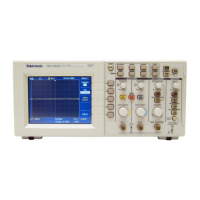Reference
Trigger Contr
ols
You c an define the trigger through the Trigger Menu a nd front-panel controls.
Trigg er Types
Three types of triggering are available: Edge, Video, and Pulse Width. A different
set of options display for each type of trigger.
Option Details
Edge (default) Triggers the oscilloscope on the rising o r falling edge of the input
signal when it crosses the trigger level (threshold)
Video
Displays NTSC or PAL/SECAM standard composite video
waveforms; you trigger on fields or lines of video signals. (See
page 98, Video Trigger.)
Pulse
Triggers on aberrant pulses. (See page 99, Pulse Width Trigger.)
Edge Trigger
Use Edge triggering to trigger on the edge of the oscilloscope input signal at the
trigger threshold.
Options Settings Comments
Edge With Edge highlighted, the rising or
falling edge of the input signal is used
for the trigger
Source CH1, CH2, CH3
1
,CH4
1
,
Ext, Ext/5, AC Line
Select the input source as the trigger
signal (See page 97.)
Slope
Rising, Falling
Select to trigger on either the rising
or falling edge of the signal
Mode Auto, Normal
Select the type of triggering (Se e
page 96.)
Coupling AC, DC, Noise Reject, HF
Reject, LF R eject
Selects the components of the trigger
signal applied to the trigger circuitry
(See page 97.)
1
Available only on a 4-channel oscilloscope.
Trigger Frequency R eadout
The oscilloscope counts the rate at which triggerable events occur to determine
trigger frequency and displays the frequency in the lower right corner of the
screen.
NOTE. The trigger frequency readout shows the frequency of e vents the
oscilloscope might consider to be a trigger, and may be less than the frequency of
the input signal in Pulse Width trigger mode.
Key Points
Mode Options. The Auto mode (default) forces the o scilloscope to trigger when it
does not detect a trigger within a certain amount of time based on the horizontal
96 TDS2000C and TDS1000C-EDU Series Oscilloscope User Manual
